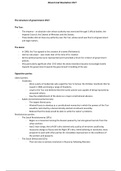Lecture notes
AQA AS/A-Level Revolution and Dictatorship Unit 2N, Chapter 1: Dissent and Revolution 1917
- Institution
- AQA
Comprehensive revision notes for the AQA AS/A-Level History Unit 2N Revolution and Dictatorship 1917-53 course, although they can be used for other syllabus'. This document covers the 1917 period, which is chapter 1 in the 'Bolshevik and Stalinist Russia 1917-64' textbook by Michael Lynch. Includes...
[Show more]




